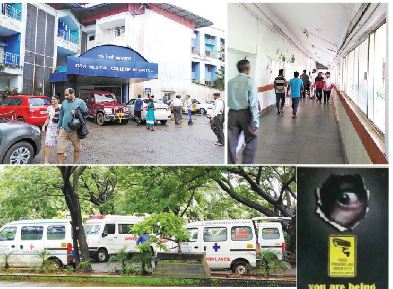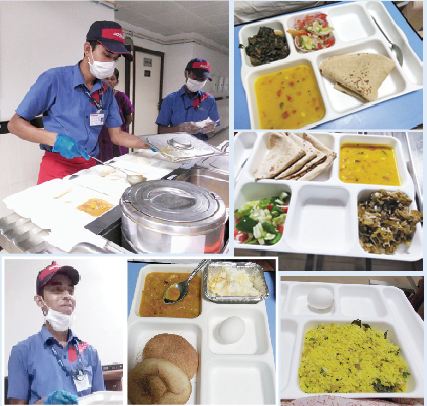Goa is abuzz with excitement as vintage bike and car owners, users, collectors and fans are decking […]

A LOT HAS CHANGED AT THE GMC!
MIND & BODY, HEART & SOUL, Sept 14- Sept 20 2019 September 13, 2019Glimpses of new GMC: Better lit, more discipline, less litter… Only patients may be dropped off or picked up at the entrance and no loitering around or a security guard will come up and solicitiously enquire your business of the day. One of the posters of Big Brother watching you!
Lots of good news at the new Goa Medical College & Hospital, and some bad and ugly, says Tara Narayan
GOA is on the move. Or at least its much admired healthcare infrastructure is moving and metamorphosing anew! Take its premier medical college and hospital, the Goa Medical College & Hospital. A recent visit revealed that it has acquired a bright and sparkling American efficiency and French elegance mirrored in the smart, young, uniformed Sodexo teams of smart young men and women who present themselves on the dot of time with trolleys loaded with their meal services of breakfast, lunch, tea and dinner, capped by a glass of milk to sleep on.
Goa’s premier hospital — the historical Goa Medical College & Hospital or GMC has finally lost its old world rusticating in time bhoot bangla image! Remember the rural malingering patches of wild greenery here and there offering shelter to the sacred cows coming home to chew their green, green grass of home? Those days are gone. Although on the odd occasion one may still catch the odd lurking cow at the gates, hoping to saunter in when security is not looking.
In a recent trip around as attendant to a dengue patient I noticed that even the wandering around cockerals and their harem of hens have been sacrificed and consumed as tandoori chicken, courtesy strict instructions from Goa’s ambitious, sometimes debonair Health Minister Vishwajit Rane. So no cows and cockerals, but dear Mr Rane, what about the sorry plight of dogs hanging around the one time sprawling complex which is rapidly filling up with more and more new buildings — this time a brand new ten speciality hospital block is coming up, it’s going to be the latest acquisition in Goa’s healthcare map. Soon there will be no more green spaces left for medical staff or patients to rest and recreate, take a morning or evening walk.
Never mind that water may forever be in short supply in the aam aadmi wards at any given point of time and housekeeping still leaves a lot to be desired – although I hear it has improved vastly and no bandicoots party in the broken hollows of false ceilings. One patient complained they recently got no water for three days until the water tankers came. Patients still have to do with rationed water and when water runs out the sister or nurse on duty has call up the hospital’s waterworks department to make some arrangements for more water for patients in the bathroom, but first you have to summon up courage to go and register a complaint about there being no water or anything else.
Spending some time with a dengue patient in the private general ward No121 on the first floor of the old Casualty building can be quite entertaining and rewarding! Casualty is always crowded but these days you may count as many as ten new dengue patients daily from one report. Most patients get accommodated in the general wards, or if you’re lucky and can afford it, you may ask for one of the paid-for rooms of general ward No.121. They have about 21 rooms, some of them sharing rooms with two patients per room. This is in the so-called VIP ward, shiningly spick and span with gleaming corridors down which one may find in the late evening the odd patient taking a walk up and down. The rooms sport state-of-the-art beds to cater to any patient in critical condition.
Funny, most folk don’t know there’s a private air-conditioned ward at the GMC with 21 private rooms, bathrooms attached, even balconies. It’s like another world apart. Security guards the ward around the clock and stops anyone without a pass from coming in for a stroll. Also be sure to leave your footwear outside or take it off at least.
Sometimes the ward is full with doctors referring their more critical care patients to a room if vacant but the rooms may also go a-begging for patients who can afford them. One extra-special VIP room here is permanently closed for use by politicians and their requests. The late Chief Minister Manohar Parrikar had spent a couple of days here although his nursing needs were taken care of by exclusive nursing staff from the Cardiology Department.
IT IS a very different life out here in Ward No.121. It is only when one settles in with the patient one discovers some flaws. Nobody likes to nitpick but the bedside bell to call nursing staff on duty in a crisis has been dysfunctional for almost eight months, although several complains have been lodged. With no bell system in place, patients behind closed doors remain incommunicado or they or their attendants may get in touch with the duty nurse personally or be smart enough to note down the nursing station telephone number and call from a mobile on the number, hoping somebody would pick up.
Even in Casualty one noticed how floors are swept and mopped often leaving a faint aroma of disinfectant in the air. There is always the rush of patients and their families with baggage in tow leaving or new patients coming in — there is no hanging around in Casualty, a young team of doctors hustle and bustle things along from patient’s inventory of health problems, shunting them off on cold shining stainless steel stretchers for X-raying or ultra-sonography pictures of what is bothering their insides, the usual melee to be first in the queue.
Dengue can be tricky. There are two kinds of dengue fever victims, Those who suffer less and those who suffer more if they’ve picked up the dangerous haemorhic dengue strain which leads to dramatic fall in platelet count and internal bleeding and external bleeding. Antibiotics, platelet transfusion and other drugs take their toll as a patient’s energy reserves weaken and life itself becomes a drag with little desire to drink water, although Sister Preeti, Sister Janet, Sister Marcalini and whoever is on duty come and go, urging the patient to drink more water, and even don’t ask for home food! Please eat the newly incorporated service of hygienically and nutritionally prepared Sodexo meals which turn up regularly.
Various doctors who are old friends turn up to evaluate and re-evaluate the parameters of the patient’s health. First the face is flushed with red rashes and they spread to the feet, the terror of diabetes too makes its appearance (courtesy of years of neglected eating habits). More prescriptions. More stomach collapses. One morning the water ceases to flow in the bathroom but mercifully it returns. Blood is collected regularly to check if blood sugar, etc, is getting back to normal…sometimes you think it is touch and go with the patient asking for arsenic in his sugarless Sodexo tea and meals!
Occasionally a lunch recommended by one of the GMC dieticians arrives but when the obstinate patient refuses it, it is the patient’s wife attending to him who eats up the meal rather than return it or let it go waste! Attendants don’t count for much and they are entitled only to a side couch, no Sodexo meals. For meals they may go down and eat at the canteen but they may not bring their meals or snacks back to the patient’s room… which is not practical and hard on the attendant, if I may so.
One day when I complained to Sister Michelle that the patient was not interested in his Goan bran-rich bread and tomato bhaji and therefore I ate it, she scolded me, “You must pyar se make the patient eat and not eat it up yourself!” A nurse after my own heart but she has no idea of what happens to a patient’s mindset in hospital when health is precarious and full of fear of a consistently collapsing stomach
The patient was reviving from dengue but one day past midnight complained of severe stomach pain. At the nursing station a tired-out sister was dozing off on her chair but she came quickly and prescribed a paramacetol for the pain which in his doctor’s file notes was permitted. As for the dengue fever, mercifully it faded away over five days, but the insulin highs and lows remained and once the pin-prick blood sugar test registers 200 it is time to inject some insulin…something to depress an already stressed out patient. Still, there is life at the end of the tunnel and all is as well as it can be. Time to return home anew to fight another fight, the last fight or the second-last fight, or may be many more good fights!
One must note here that the private ward No.121 rooms are not for free but come for 1,300 to750 per room, depending on whether it is being shared or not with another patient. Some patients invest in a private room in case of a long stay as in the case of a young woman with a difficult pregnancy, she and her mother were sharing a room and they could be here for two months so that her doctor could ensure her rest and monitor her pregnancy better.
In one room a senior citizen was being fed on a liquid diet through a nasal tube. Utterly helpless, there was an attendant taking care of him while his daughter and other family members relieved him at night. From Belgaum, the daughter said they consider the GMC offers better care and facilities — of course, if you can pay for the private ward rooms! Alas, it is not such a happy scenario out in the 21 odd or so general wards of the GMC, the aam aadmi wards — here there may be 13 beds but 30 patients, some accommodated on the floor! The nursing station here may have just two nurses working in three shifts and needless to say they’re constantly in demand courtesy the needs of various patients or their attendants.
Most attending doctors prefer to put critical patients in the wards where if something happens it comes to the notice of the nursing sister quickly, confided one nurse, “It’s mostly stable patients who go to ward No.121 where they may recover in more comparative peace!” The usual hierarchy of attending doctors is in place with junior MBBS doctors being more on the spot while senior doctors do their rounds in the morning and come again only if their juniors can’t handle an emergency!
TAKE A LOOK AT SODEXO MEALS…

THE Sodexo meals have arrived at the GMC, both in the general aam aadmi wards and paid-for rooms of Ward No.121. In Goa it’s hard to believe in so much efficiency but the service is amazing — Health Minister Vishwajit Rane signed the reportedly `16 crore contract for five years with the international French giant of Sodexo (whatever it means) to provide health-conscious meals at the GMC wards there has been a lot of talk of how good they are or how impractical! According to Sodexo-hired nutrititionist Jayanti Mondal (a young Bengali girl who did her MSC in Science Technology and Nutrition from Periyar University in Salem (Tamilnadu), “The food is cooked by Chefs Deepak, Gautam, Utpal, Jayanta in the GMC kitchen and they cook about 500 to 640 meals max each day for the patients…apart from the full normal diet meals we have diabetes normal diet, salt-restricted diet for kidney patients and so on.”
Most of their 50 or so strong “stewards” working in three shifts deliver the meals of early morning tea (with/without sugar), then breakfast, lunch, teatime and dinner. It is efficient, uniformed teamwork, with most of the young workers from Calcutta/West Bengal or Uttar Pradesh. If I seek more information she referred me to their Operations Manager in Goa, Debrata Ghosh (who is from Bangalore).
Breakfast may be an egg/protein drink, light one-egg white omlette, Indian favourites of upma or poha, tea. The lunch and dinner meals are satisfying in so much as there will be four thin chapatti, a portion of rice, a sabzi, a dal and a very generous helping of sliced/slivered salad with a light flavouring. Low in oil if at all and flavourful without being overly salty. Local vegetables like bottle and ribbed gourd are used and there may be a scattering of grated coconut — one sabzi I found extremely flavourful, high in fibre and delicious as a meal all on its own!
They try to be eco-friendly but the cardboard glasses are thin and may collapse if a patient does not pick them up delicately — a hot tea spill is possible! Take your tea in a double cup if you wish. All the wards get the same vegetarian meals, eggs/omlette are the only non-vegetarian protein source included. Smiled one of the team leaders to a query, “I would say most patients like the meals but may be 20% don’t!” Although by way of a Goan breakfast they also do Goan poie-tangy “tomato-onion gravy bhaji.” The portions are more than generous and both patient and attendant may share if desired with each preferring different things on the meal platter.
Sodexo first started its hospital operation at the Manipal Hospital and since then they’ve been so well accepted that they’re pretty much doing well in several places, be it at the GMC or some large corporate offices.














